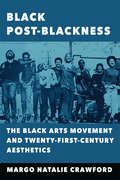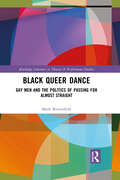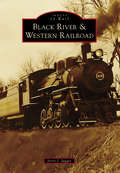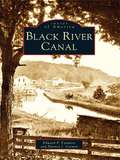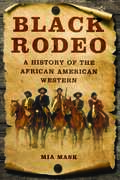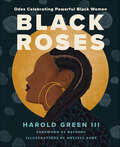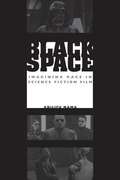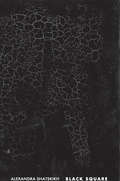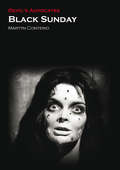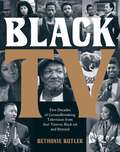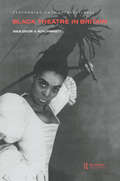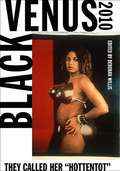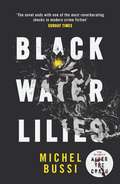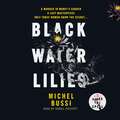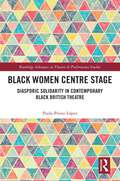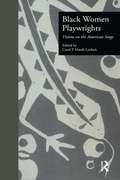- Table View
- List View
Black Post-Blackness: The Black Arts Movement and Twenty-First-Century Aesthetics
by Margo Natalie CrawfordA 2008 cover of The New Yorker featured a much-discussed Black Power parody of Michelle and Barack Obama. The image put a spotlight on how easy it is to flatten the Black Power movement as we imagine new types of blackness. Margo Natalie Crawford argues that we have misread the Black Arts Movement's call for blackness. We have failed to see the movement's anticipation of the "new black" and "post-black." Black Post-Blackness compares the black avant-garde of the 1960s and 1970s Black Arts Movement with the most innovative spins of twenty-first century black aesthetics. Crawford zooms in on the 1970s second wave of the Black Arts Movement and shows the connections between this final wave of the Black Arts movement and the early years of twenty-first century black aesthetics. She uncovers the circle of black post-blackness that pivots on the power of anticipation, abstraction, mixed media, the global South, satire, public interiority, and the fantastic.
Black Power TV
by Devorah HeitnerIn Black Power TV, Devorah Heitner chronicles the emergence of Black public affairs television starting in 1968. She examines two local shows, New York's Inside Bedford-Stuyvesant and Boston's Say Brother, and the national programs Soul! and Black Journal. These shows offered viewers radical and innovative programming: the introspections of a Black police officer in Harlem, African American high school students discussing visionary alternatives to the curriculum, and Miriam Makeba comparing race relations in the United States to apartheid in South Africa. While Inside Bedford-Stuyvesant and Say Brother originated from a desire to contain Black discontent during a period of urban uprisings and racial conflict, these shows were re-envisioned by their African American producers as venues for expressing Black critiques of mainstream discourse, disseminating Black culture, and modeling Black empowerment. At the national level, Soul! and Black Journal allowed for the imagining of a Black nation and a distinctly African American consciousness, and they played an influential role in the rise of the Black Arts Movement. Black Power TV reveals how regulatory, activist, and textual histories are interconnected and how Black public affairs television redefined African American representations in ways that continue to reverberate today.
Black Privilege: Opportunity Comes to Those Who Create It
by Charlamagne Tha God<P>Charlamagne Tha God—the self-proclaimed “Prince of Pissing People Off,” co-host of Power 105.1’s The Breakfast Club, and “hip-hop’s Howard Stern”—shares his unlikely success story as well as how embracing one’s truths is a fundamental key to success and happiness. <P>In his new book, Charlamagne Tha God presents his comic, often controversial, and always brutally honest insights on how living an authentic life is the quickest path to success. Beginning with his journey from the small town of Moncks Corner, South Carolina to his headline grabbing interviews with celebrities like Justin Bieber, Jay-Z, Nicki Minaj, Kanye West, and Hillary Clinton, he shares how he turned his troubled early life around by owning his (many) mistakes and refusing to give up on his dreams, even after his controversial opinions got him fired from several on-air jobs. <P>Combining his own story with bold advice and his signature commitment to honesty at all costs, Charlamagne hopes this book will give others the confidence to live their own truths. <P><b>A New York Times Bestseller</b>
Black Queer Dance: Gay Men and the Politics of Passing for Almost Straight (ISSN)
by Mark BroomfieldThis book is a groundbreaking exploration of black masculinity and sexual passing in American contemporary dance.Based on ethnographic fieldwork in New York City, the book features keen observations and in-depth interviews with acclaimed dancer-choreographers Desmond Richardson and Dwight Rhoden Co-Artistic Directors of Complexions Contemporary Ballet and Ronald K. Brown, Artistic Director of Evidence. Black Queer Dance examines one of the most visible crucibles for masculinity—the male dancer—and illuminates the contradictory and conditional acceptance of black gay men’s contributions to American modern dance. The book questions the politics of "coming out" and situates a new framework of "doing out" for understanding marginalized black LGBTQ people in the 20th and 21st century. Narratives of black queer male dancers’ performance of identity reveals the challenges posed navigating strategic gender performances in a purportedly post-gay and post-race American culture. Broomfield demonstrates how the experiences of black queer, gender nonconforming, and nonbinary men expose the illusions of all masculine gender performances. Drawing on masculinity studies, dance studies, critical race and performance theory, and queer studies Black Queer Dance implicates the author’s embodied history, autoethnography, memoir and poetry that shines light on how black queer men offer an expansive vision of masculinity.This book will be a vital read for graduate and undergraduate students within dance and performance studies.
Black River & Western Railroad (Images of Rail)
by Jerry J. JaggerThe Black River & Western Railroad has provided over 50 continuous years of passenger excursions in rural New Jersey between Flemington and Ringoes, passing through the pristine scenery of Hunterdon County. May 16, 1965, was the first official day of steam-powered passenger excursions, and 50 years later, on May 16, 2015, the same steam locomotive provided power for another steam-powered excursion. During those years, the railroad has grown from the simple excursion attraction of historic railroad equipment, providing the public amusement, to a regional short-line railroad.
Black River Canal (Images of America)
by Edward P. Fynmore Harney J. CorwinBlack River Canal documents in images how a manmade river transformed a region. This upper New York State canal was an improbable engineering success. In 1825, DeWitt Clinton proposed construction of a canal that would link the Erie Canal at Rome with the Black River at Lyons Falls. The idea was well received, but the obstacles were great. The canal would have to run uphill. In the end, the 35-mile overland canal required a record 109 locks to negotiate a rise and fall of 1,079 feet. Construction was authorized in 1836, and against all odds, the Black River Canal was fully operational in 1855. The canal brought a measure of prosperity to an isolated region of the state and promoted development of a wood products industry that continues to this day.
Black Rodeo: A History of the African American Western
by Mia MaskAfrican American westerns have a rich cinematic history and visual culture. Mia Mask examines the African American western hero within the larger context of film history by considering how Black westerns evolved and approached wide-ranging goals. Woody Strode’s 1950s transformation from football star to actor was the harbinger of hard-edged western heroes later played by Jim Brown and Fred Williamson. Sidney Poitier’s Buck and the Preacher provided a narrative helmed by a groundbreaking African American director and offered unconventionally rich roles for women. Mask moves from these discussions to consider blaxploitation westerns and an analysis of Jeff Kanew’s hard-to-find 1972 documentary about an all-Black rodeo. The book addresses how these movies set the stage for modern-day westploitation films like Django Unchained. A first-of-its kind survey, Black Rodeo illuminates the figure of the Black cowboy while examining the intersection of African American film history and the western.
Black Roses: Odes Celebrating Powerful Black Women
by Harold GreenThe poet and founder of the music collective Flowers for the Living pays tribute to all Black women by focusing on visionaries and leaders who are making history right now, including Ava DuVernay, Janelle Monae, Kamala Harris, Misty Copeland, Nikole Hannah-Jones, Robin Roberts, Roxane Gay, and Simone Biles—with this compilation of celebratory odes featuring full-color illustrations by Melissa Koby.Black women are exceptional. To honor how Black women use their minds, talent, passion, and power to transform society, Harold Green began writing love letters in verse which he shared on his Instagram account. Balm for our troubled times, his tributes to visionaries and leaders quickly went viral and became a social media sensation. Now, in this remarkable collection, Green brings together many of these popular odes with never-before-seen works. A timely celebration of contemporary Black figures who are making history and shaping our culture today, Black Roses is divided into five sections—advocates, curators, innovators, luminaries, trailblazers—reflecting the diversity of Black women’s achievements and the depth of their reach. These inspiring changemakers are leaving their mark on the world by creating new beauty in their respective art forms, heading movements, fighting for equality and to change the status quo, and championing new definitions of what’s possible in every meaningful way. Green lifts them up to create meaningful connections between these figures and our own lives and experiences.Black Roses spotlights and urges readers to learn more about Allyson Felix, Angelica Ross, Ava DuVernay, Bisa Butler, Bozoma Saint John, Charisma Sweat-Green, Dr. Eve Ewing, Dr. Janice Jackson, Dr. Johnnetta Cole, Eunique Jones-Gibson, Issa Rae, Janelle Monae, Jennifer Hudson, Jessica Matthews, Kamala Harris, Keisha Bottoms, Kimberly Bryant, Kimberly Drew, Lisa Green, Lizzo, Mandilyn Graham, Mellody Hobson, Michelle Alexander, Misty Copeland, Naomi Beckwith, Nikole Hannah-Jones, Phylicia Rashad, Rapsody, Raquel Willis, Robin Roberts, Roxane Gay, Shellye Archambeau, Simone Biles, Stacey Abrams, Tabitha Brown, Tamika Mallory, Tarana Burke, Tasha Bell, Tomi Adeyemi, and Tracee Ellis Ross.
Black Sheep: The Authorised Biography of Nicol Williamson
by Gabriel HershmanOnce hailed by John Osborne as ‘the greatest actor since Brando’, latterly known as a ruined genius whose unpredictable, hellraising behaviour was legendary, Nicol Williamson always went his own way. Openly dismissive of ‘technical’ actors, or others who played The Bard as if ‘their finger was up their arse’, Williamson tore up the rule book to deliver a fast-talking canon of Shakespearean heroes, with portrayals marked by gut-wrenching passion. According to one co-star, Williamson was like a tornado on stage – ‘he felt he was paddling for his life’. Fiercely uncompromising, choosy about the roles he accepted, contemptuous of the ‘suits’ who made money from artists, and a perfectionist who never accepted second best from himself or others, Nicol sometimes alienated those around him. But even his detractors still acknowledge his brilliance. After an extraordinary career on both stage and screen, Williamson was burnt out as an actor by the age of 60. Yet, as Gabriel Hershman explains in this authorised biography, a premature end was perhaps inevitable for an actor who always went the extra mile in every performance.
Black Soundscapes White Stages: The Meaning of Francophone Sound in the Black Atlantic (The <I>Callaloo</I> African Diaspora Series)
by Edwin C. Hill Jr.An innovative look at the dynamic role of sound in the culture of the African Diaspora as found in poetry, film, travel narratives, and popular music.Black Soundscapes White Stages explores the role of sound in understanding the African Diaspora on both sides of the Atlantic, from the City of Light to the islands of the French Antilles. From the writings of European travelers in the seventeenth century to short-wave radio transmissions in the early twentieth century, Edwin C. Hill Jr. uses music, folk song, film, and poetry to listen for the tragic cri nègre. Building a conceptualization of black Atlantic sound inspired by Frantz Fanon's pioneering work on colonial speech and desire, Hill contends that sound constitutes a terrain of contestation, both violent and pleasurable, where colonial and anti-colonial ideas about race and gender are critically imagined, inscribed, explored, and resisted. In the process, this book explores the dreams and realizations of black diasporic mobility and separation as represented by some of its most powerful soundtexts and cultural practitioners, and it poses questions about their legacies for us today.In the process, thee dreams and realities of Black Atlantic mobility and separation as represented by some of its most powerful soundtexts and cultural practitioners, such as the poetry of Léon-Gontran Damas—a founder of the Négritude movement—and Josephine Baker’s performance in the 1935 film Princesse Tam Tam. As the first in Johns Hopkins’s new series on the African Diaspora, this book offers new insight into the legacies of these exceptional artists and their global influence.
Black South African Women: An Anthology of Plays
by Kathy A. PerkinsThis is the first anthology to focus exclusively on the lives of Black South African women. This collection represents the work of both female and male writers, including national and international award-winning playwrights. The collection includes six full-length and four one-act plays, as well as interviews with the writers, who candidly discuss the theatrical and political situation in the new South Africa. Written before and after apartheid, the plays present varying approaches and theatrical styles from solo performances to collective creations. The plays dramatise issues as diverse as: * women's rights * displacement from home * violence against women * the struggle to keep families together * racial identity * education in the old and new South Africa * and health care.
Black Space
by Adilifu NamaScience fiction film offers its viewers many pleasures, not least of which is the possibility of imagining other worlds in which very different forms of society exist. Not surprisingly, however, these alternative worlds often become spaces in which filmmakers and film audiences can explore issues of concern in our own society. Through an analysis of over thirty canonic science fiction (SF) films, including Logan's Run, Star Wars, Blade Runner, Back to the Future, Gattaca, and Minority Report, Black Space offers a thorough-going investigation of how SF film since the 1950s has dealt with the issue of race and specifically with the representation of blackness. Setting his study against the backdrop of America's ongoing racial struggles and complex socioeconomic histories, Adilifu Nama pursues a number of themes in Black Space. They include the structured absence/token presence of blacks in SF film; racial contamination and racial paranoia; the traumatized black body as the ultimate signifier of difference, alienness, and "otherness"; the use of class and economic issues to subsume race as an issue; the racially subversive pleasures and allegories encoded in some mainstream SF films; and the ways in which independent and extra-filmic productions are subverting the SF genre of Hollywood filmmaking. The first book-length study of African American representation in science fiction film, Black Space demonstrates that SF cinema has become an important field of racial analysis, a site where definitions of race can be contested and post-civil rights race relations (re)imagined.
Black Square
by Ms Marian Schwartz Aleksandra ShatskikhKazimir Malevich's painting Black Square is one of the twentieth century's emblematic paintings, the visual manifestation of a new period in world artistic culture at its inception. None of Malevich's contemporary revolutionaries created a manifesto, an emblem, as capacious and in its own way unique as this work; it became both the quintessence of the Russian avant-gardist's own art--which he called Suprematism--and a milestone on the highway of world art. Writing about this single painting, Aleksandra Shatskikh sheds new light on Malevich, the Suprematist movement, and the Russian avant-garde.Malevich devoted his entire life to explicating Black Square's meanings. This process engendered a great legacy: the original abstract movement in painting and its theoretical grounding; philosophical treatises; architectural models; new art pedagogy; innovative approaches to theater, music, and poetry; and the creation of a new visual environment through the introduction of decorative applied designs. All of this together spoke to the tremendous potential for innovative shape and thought formation concentrated in Black Square.To this day, many circumstances and events of the origins of Suprematism have remained obscure and have sprouted arbitrary interpretations and fictions. Close study of archival materials and testimonies of contemporaries synchronous to the events described has allowed this author to establish the true genesis of Suprematism and its principal painting.
Black Sunday (Devil's Advocates)
by Martyn ConterioConsiders the particularly Italian perspective on the gothic and a fresh and pioneering approach to horror tropes
Black Swan Class Sloops: Detailed in the Original Builders' Plans
by Les BrownAn illustrated reference featuring the superbly drawn plans for these highly effective anti-submarine ships. The technical details of British warships were recorded in a set of plans produced by the builders on completion of every ship. Known as the &“as fitted&” general arrangements, these drawings represented the exact appearance and fitting of the ship as it entered service. Intended to provide a permanent reference for the Admiralty and the dockyards, these plans were drawn with exquisite skill in multi-colored inks and washes that represent the acme of the draftsman&’s art. Today they form part of the collection of the National Maritime Museum at Greenwich, which is using the latest scanning technology to make digital copies of the highest quality. This book is one of a series based entirely on these drafts, depicting famous warships in unprecedented detail—complete sets in full color, with many close-ups and enlargements that make every aspect clear. Captions point the reader to important features, and an introduction covers the background to the design. This volume is devoted to the sloops of the Black Swan class and its improved derivatives, widely regarded as the &“Rolls-Royce&” of Second World War convoy escorts. Heavily armed and superbly equipped for their role, they were among the most effective anti-submarine ships of the battle in the Atlantic. The design was gradually improved and this book uses plans of four selected ships to chart that development. These comprise: Black Swan as built; Flamingo as modified later; Starling, the single most successful U-boat hunter of the war, as in 1943; and Amethyst, as refitted after her clash with Chinese communists on the Yangtze in 1949.
Black TV: Five Decades of Groundbreaking Television from Soul Train to Black-ish and Beyond
by Bethonie ButlerWith iconic imagery and engrossing text, Black TV is the first book of its kind to celebrate the groundbreaking, influential, and often under-appreciated shows centered on Black people and their experiences from the last fifty years. Over the past decade, television has seen an explosion of acclaimed and influential debut storytellers including Issa Rae (Insecure), Donald Glover (Atlanta), and Michaela Coel (I May Destroy You). This golden age of Black television would not be possible without the actors, showrunners, and writers that worked for decades to give voice to the Black experience in America. Written by veteran TV reporter Bethonie Butler, Black TV tells the stories behind the pioneering series that led to this moment, celebrating the laughs, the drama, and the performances we&’ve loved over the last fifty years. Beginning with Julia, the groundbreaking sitcom that made Diahann Carroll the first Black woman to lead a prime-time network series as something other than a servant, she explores the 1960s and 1970s as an era of unprecedented representation, with shows like Soul Train, Roots, and The Jeffersons. She unpacks the increasingly nuanced comedies of the 1980s from 227 to A Different World, and how they paved the way for the &’90s Black-sitcom boom that gave us The Fresh Prince of Bel-Air and Living Single. Butler also looks at the visionary comedians—from Flip Wilson to the Wayans siblings to Dave Chappelle—and connects all these achievements to the latest breakthroughs in television with showrunners like Shonda Rhimes, Ava DuVernay, and Quinta Brunson leading the charge. With dozens of photographs reminding readers of memorable moments and scenes, Butler revisits breakout performances and important guest appearances, delivering some overdue accolades along the way. So, put on your Hillman sweatshirt, make some popcorn, and get ready for a dyn-o-mite retrospective of the most groundbreaking and entertaining shows in television history.
Black Theatre in Britain
by TompsettFirst Published in 1998. Routledge is an imprint of Taylor & Francis, an informa company.
Black Venus 2010: They Called Her "Hottentot"
by Deborah WillisAs a young South African woman of about twenty, Saartjie Baartman, the so-called “Hottentot Venus,” was brought to London and placed on exhibit in 1810. Clad in the Victorian equivalent of a body stocking, and paraded through the streets and on stage in a cage she became a human spectacle in London and Paris. Baartman’s distinctive physique became the object of ridicule, curiosity, scientific inquiry, and desire until and after her premature death. The figure of Sarah Baartman was reduced to her sexual parts. Black Venus 2010 traces Baartman’s memory in our collective histories, as well as her symbolic history in the construction and identity of black women as artists, performers, and icons. The wide-ranging essays, poems, and images in Black Venus 2010 represent some of the most compelling responses to Baartman. Each one grapples with the enduring legacy of this young African woman who forever remains a touchstone for black women. Contributors include: Elizabeth Alexander, Holly Bass, Petrushka A Bazin, William Jelani Cobb, Lisa Gail Collins, Renée Cox, J. Yolande Daniels, Carole Boyce Davies, Leon de Wailly, Manthia Diawara, Diana Ferrus, Cheryl Finley, Nikky Finney, Kianga K. Ford, Terri Francis, Sander Gilman, Renée Green, Joy Gregory, Lyle Ashton Harris, Michael D. Harris, Linda Susan Jackson, Kellie Jones, Roshini Kempadoo, Simone Leigh, Zine Magubane, E. Ethelbert Miller, Robin Mitchell, Charmaine Nelson, Tracey Rose, Radcliffe Roye, Bernadette Searle, Lorna Simpson, Debra S. Singer, Penny Siopis, Hank Willis Thomas, Kara Walker, Michele Wallace, Carla Williams, Carrie Mae Weems, J. T. Zealy, and the editor.
Black Water Lilies: 'A dazzling, unexpected and haunting masterpiece' Daily Mail
by Michel BussiTHE INTERNATIONAL BESTSELLER 'Ends with one of the most reverberating shocks in modern crime fiction' The Sunday Times 'A dazzling, unexpected and haunting masterpiece' Daily Mail 'A work of genius... Stunning' Daily Express Jérôme Morval has been found dead in the stream that runs through the gardens at Giverny, where Monet did his famous paintings. In Jérôme's pocket is a postcard of Monet's 'Water Lilies' with the words: Eleven years old. Happy Birthday.Entangled in the mystery are three women: a young painting prodigy, the seductive village schoolteacher and an old widow who watches over the village from a mill by the stream. All three of them share a secret. But what do they know about Jérôme's death? And what is the connection to the mysterious 'Black Water Lilies', a rumoured masterpiece by Monet that has never been found?MICHEL BUSSI: THE MASTER OF THE KILLER TWIST ''A novel so extraordinary that it reminded me of reading Stieg Larsson for the very first time' The Sunday Times on After the Crash'Inventive, original and incredibly entertaining' Sunday Mirror on Don't Let Go 'Combines an extraordinarily inventive plot with characters haunted by long-ago events - and demonstrates why he has such a hold on readers' The Times on Time Is A Killer
Black Water Lilies: 'A dazzling, unexpected and haunting masterpiece' Daily Mail
by Michel BussiGiverny. During the day, tourists flock to the former home of the famous artist Claude Monet and the gardens where he painted his Water Lilies. But when silence returns, there is a darker side to the peaceful French village.This is the story of thirteen days that begin with one murder and end with another. Jérôme Morval, a man whose passion for art was matched only by his passion for women, has been found dead in the stream that runs through the gardens. In his pocket is a postcard of Monet's Water Lilies with the words: Eleven years old. Happy Birthday.Entangled in the mystery are three women: a young painting prodigy, the seductive schoolteacher and an old widow who watches over the village from a mill by the stream. All three of them share a secret. But what do they know about the discovery of Jérôme Morval's corpse? And what is the connection to the mysterious, rumoured painting of Black Water Lilies?(p) 2016 Orion Publishing Group
Black Women Centre Stage: Diasporic Solidarity in Contemporary Black British Theatre (Routledge Advances in Theatre & Performance Studies)
by Paola Prieto LópezThis book examines the political alliances that are built across the diaspora in contemporary plays written by Black women playwrights in the UK. Through the concept of creative diasporic solidarity, it offers an innovative theoretical approach to examine the ways in which the playwrights respond creatively to the violence and marginalisation of Black communities, especially Black women. This study demonstrates that theatre can act as a productive space for the ethical encounter with the Other (understood in terms of alterity, as someone different from the self) by examining the possibilities of these plays to activate the spectators’ responsibility and solidarity towards different types of violence experienced by Black women, offering alternative modes of relationality. The book engages with a range of contemporary works written by Black women playwrights in the UK, including Mojisola Adebayo, Theresa Ikoko, Diana Nneka Atuona, Gloria Williams, Charlene James, or Yusra Warsama, bringing to the fore a gendered and intersectional approach to the analysis of the texts. This book will be of great interest to students and scholars in contemporary theatre, gender studies and diaspora studies.
Black Women Directors (Quick Takes: Movies and Popular Culture)
by Christina N. BakerBlack women have long recognized the power of film for storytelling. For far too long, however, the cultural and historical narratives about film have not accounted for the contributions of Black women directors. This book remedies this omission by highlighting the trajectory of the culturally significant work of Black women directors in the United States, from the under-examined pioneers of the silent era, to the documentarians who sought to highlight the voices and struggles of Black women, and the contemporary Black women directors in Hollywood. Applying a Black feminist perspective, this book examines the ways that Black women filmmakers have made a way for themselves and their work by resisting the dominant cultural expectations for Black women and for the medium of film, as a whole.
Black Women Film and Video Artists (AFI Film Readers)
by Jacqueline BoboFirst published in 1998. Routledge is an imprint of Taylor & Francis, an informa company.
Black Women Playwrights: Visions on the American Stage (Studies in Modern Drama #Vol. 11)
by Carol P. Marsh-LockettFirst published in 1999. Routledge is an imprint of Taylor & Francis, an informa company.
Black Women's Art Ecosystems: Sites of Wellness and Self-Care (New Black Studies Series)
by Tanisha JacksonIt is not an uncommon burden but rather a choice that Black women artists embrace creating art as a socio-political strategy to save themselves and their communities. Tanisha M. Jackson analyzes visual and personal narratives, historical archives, and artmaking practices to reveal how Black women artists facilitate wellness through creative expression and cultural knowledge. Delving into historical and contemporary practices, Jackson looks at Black women who use their artwork as acts of resistance, self-expression, and holistic wellness. Jackson’s multidisciplinary approach blends art history, Black studies, and personal narratives to examine the ways that the art ecosystems created by these women foster resilience and empowerment. Their dramatic stories underscore the transformative power of art in cultivating activism and mental, emotional, and spiritual well-being but also provide a framework for understanding how art can be a vital component of self-care and communal wellness. A meticulous portrait and inspiring roadmap, Black Women’s Art Ecosystems celebrates Black women’s artistic achievements while revealing how their work creates communities of restoration and mental health.
